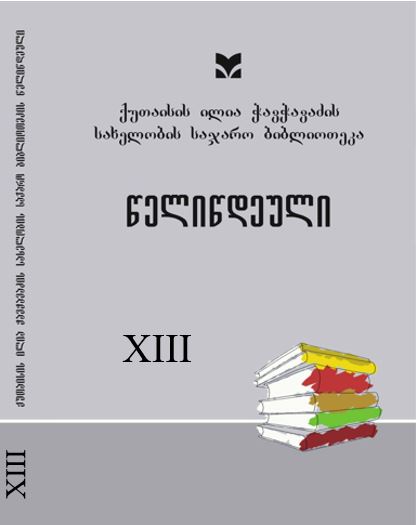Linguistic Peculiarities of Medieval Kakheti Epigraphic Monuments
DOI:
https://doi.org/10.48614/yk.13.2021.83-91Keywords:
Epigraphy Monuments, Kakheti, Linguistic Changes, Phonetic-Phonological PeculiaritiesAbstract
The article discusses some linguistic features of the epigraphic monuments of medieval Kakheti, in particular the events that are particularly interesting in terms of the phonetic-phonological study of these monuments.
1. In the written monuments of medieval Kakheti, in order to convey the Asomtavruli Q [ჲ] allophone, it is found in all the positions where it can be expected. Violations during its use are quite frequent since the IX century, but according to these data already from the XI century the absence of diphthongs in oral speech, as Z. Sarjveladze and L.Basilaia suggested, is not proven.
In Khutsuri monuments of the XII-XVI centuries, the Q grapheme is actively revealed in accordance with orthographic norms; e.g. [ა ჲ], [ო ჲ], [უ ჲ] diphthongs are also presented. In the monuments of the XI-XV centuries written in the Mkhedruli alphabet, in all the positions where [ჲ] was expected, there is [ა].
We believe that in this period, as well as in the archaic or V-VIII centuries of Georgian language there was a phoneme /ი/, whose syllabic [i] and nonsyllabic [ჲ] allophones were conveyed by the graphemes b and Q, respectively. In our opinion, for this period some transcribers or performers find it difficult to distinguish between [ი] and [ჲ] sounds. The fluctuations in the perception of [i] and [ჲ] allophones cause fluctuations in orthographic norms: confusion of the writings of the graphs Q and b.
2. In the monuments made in Asomtavruli in the X-XI centuries, we have 79.5% d spelling and 20.5% e spelling. Only the d sits in the position between the sonorant consonant and the vowel. The V-s observed in the C-C position are found mainly in the /khav/ stem, as well as in the descending stems, after sonorants and adverbs as a sign of the S1 person.
When detecting graphemes d and e in the Khutsuri monuments of the XIIXVIII centuries, the peculiarities increase in positions C-V and C-C, which are interesting for us.
In the XII-XVIII century works created with the Mkhedruli alphabet in CN-V and CS-V, and C-C positions violations of orthographic norms while revealing V are widely detected.
In general, as the analyzed material showed, the peculiarities that appear in terms of phonetic or phonematic structure in the epigraphic monuments of medieval Kakheti, the issue of ascending or descending diphthongs containing [ჲ], detection and transmission of [ვ], and [უ] allophones, establishing uჁ grapheme sequence in the C-C position between consonants, detection of ჴ grapheme positions, frequency, and confusion of its usage, unexpectedness in phonetic processes...) echoes and is similar to the peculiarities that can be found in the monuments made in different parts of Georgia during the same period.
Events confirmed in the monuments of the X-XIII centuries are especially interesting, which are conditioned and explained by the transition period during the development of the Georgian alphabet as well as the Georgian literary language. From the linguistic point of view, this is a very difficult and interesting time. It’s a period when the Mkhedruli alphabet starts to develop from the Nuskhuri alphabet, and transition from so called old Georgian writing style to the middle period or a new style of literary language takes place.




